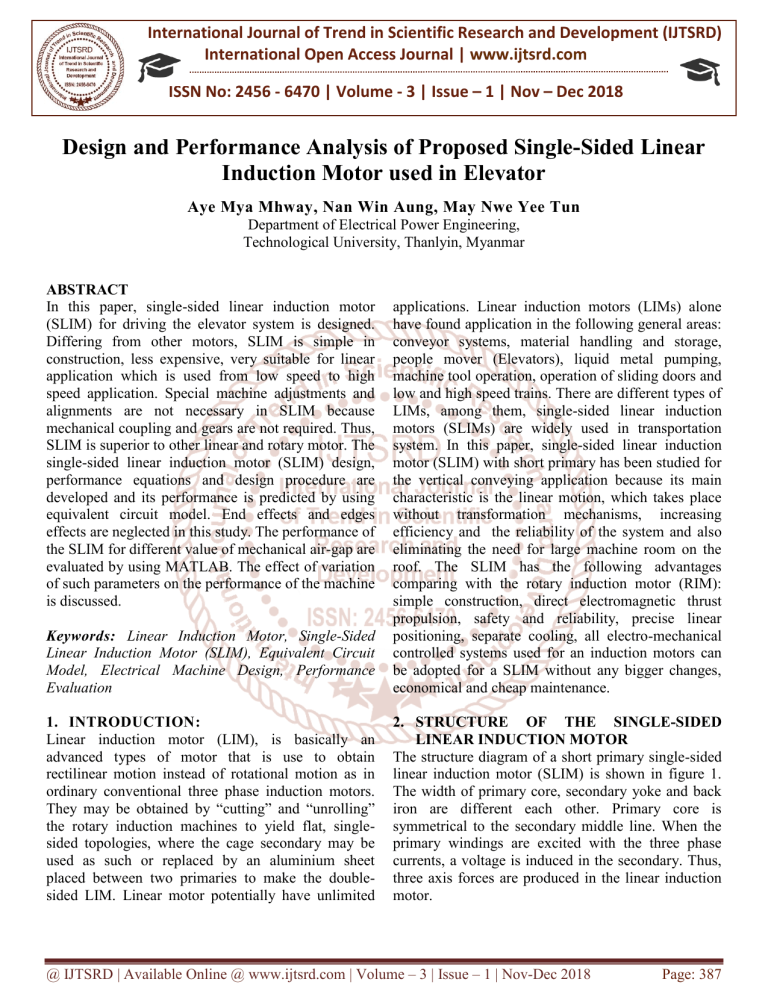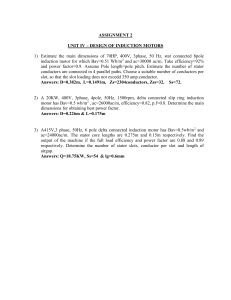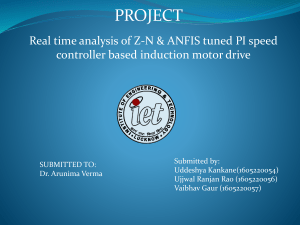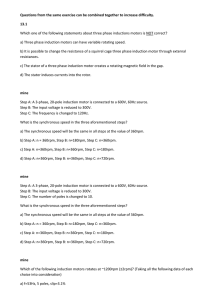
International Journal of Trend in Scientific Research and Development (IJTSRD)
International Open Access Journal | www.ijtsrd.com
ISSN No: 2456 - 6470 | Volume - 3 | Issue – 1 | Nov – Dec 2018
Design and Performance Analysis of Proposed Single-Sided Linear
Induction Motor used in Elevator
Aye Mya Mhway, Nan Win Aung, May Nwe Yee Tun
Department of Electrical Power Engineering,
Technological University, Thanlyin, Myanmar
ABSTRACT
In this paper, single-sided linear induction motor
(SLIM) for driving the elevator system is designed.
Differing from other motors, SLIM is simple in
construction, less expensive, very suitable for linear
application which is used from low speed to high
speed application. Special machine adjustments and
alignments are not necessary in SLIM because
mechanical coupling and gears are not required. Thus,
SLIM is superior to other linear and rotary motor. The
single-sided linear induction motor (SLIM) design,
performance equations and design procedure are
developed and its performance is predicted by using
equivalent circuit model. End effects and edges
effects are neglected in this study. The performance of
the SLIM for different value of mechanical air-gap are
evaluated by using MATLAB. The effect of variation
of such parameters on the performance of the machine
is discussed.
Keywords: Linear Induction Motor, Single-Sided
Linear Induction Motor (SLIM), Equivalent Circuit
Model, Electrical Machine Design, Performance
Evaluation
applications. Linear induction motors (LIMs) alone
have found application in the following general areas:
conveyor systems, material handling and storage,
people mover (Elevators), liquid metal pumping,
machine tool operation, operation of sliding doors and
low and high speed trains. There are different types of
LIMs, among them, single-sided linear induction
motors (SLIMs) are widely used in transportation
system. In this paper, single-sided linear induction
motor (SLIM) with short primary has been studied for
the vertical conveying application because its main
characteristic is the linear motion, which takes place
without transformation mechanisms, increasing
efficiency and the reliability of the system and also
eliminating the need for large machine room on the
roof. The SLIM has the following advantages
comparing with the rotary induction motor (RIM):
simple construction, direct electromagnetic thrust
propulsion, safety and reliability, precise linear
positioning, separate cooling, all electro-mechanical
controlled systems used for an induction motors can
be adopted for a SLIM without any bigger changes,
economical and cheap maintenance.
1. INTRODUCTION:
Linear induction motor (LIM), is basically an
advanced types of motor that is use to obtain
rectilinear motion instead of rotational motion as in
ordinary conventional three phase induction motors.
They may be obtained by “cutting” and “unrolling”
the rotary induction machines to yield flat, singlesided topologies, where the cage secondary may be
used as such or replaced by an aluminium sheet
placed between two primaries to make the doublesided LIM. Linear motor potentially have unlimited
2. STRUCTURE OF THE SINGLE-SIDED
LINEAR INDUCTION MOTOR
The structure diagram of a short primary single-sided
linear induction motor (SLIM) is shown in figure 1.
The width of primary core, secondary yoke and back
iron are different each other. Primary core is
symmetrical to the secondary middle line. When the
primary windings are excited with the three phase
currents, a voltage is induced in the secondary. Thus,
three axis forces are produced in the linear induction
motor.
@ IJTSRD | Available Online @ www.ijtsrd.com | Volume – 3 | Issue – 1 | Nov-Dec 2018
Page: 387
International Journal of Trend in Scientific Research and Development (IJTSRD) ISSN: 2456-6470
Number of slot per pole per phase,
Aluminum thickness,
Width of stator,
Mechanical air gap,
q1 =1
d=3mm
Wst =1000mm
g m =5mm
Continuously, to obtain the target thrust in a SingleSided Linear Induction Motor, the following
equations are used.
Figure 1.Structure of the single-sided linear induction
motor (SLIM)
3. DESIGN PROCEDURE OF SINGLE-SIDED
LINEAR INDUCTION MOTOR
The specifications of SLIM
Targe thrust, F's
: 16000 N
Rated velocity, vr
:
10 m/s
Rated Slip, s
: 10%
Rated line voltage, V1 : 400 V
Number of phase, m
: 3phase
Number of poles, p
: 4poles
Frequency, f
: 50 Hz
Types of winding: Single Layer Winding And, this
machine is supposed to be applied in the elevator,
achieving vertical transportation with ascending/rising
speed vr and acceleration a up to 10m/s and 2m/s2
upwards, respectively. Therefore, the size of the
cabin, total weight of cabin and necessary mechanical
connection to it, and maximum allowable passenger
and the average weight of each passenger are needed
to know. All the necessary information are mentioned
below
Size of cabin,(height ×length ×width)cabin =2.5 ×2
×1m3
Total weight of cabin and bearing, mcabin
: 500kg
Number of passenger in one cabin, np
:5
Average weight of each passenger, mpassenger : 75kg
3.1 Design of Primary (Stator)
Stator unit is designed according to the following
procedure. First, assign the constant values
μ 0 =4π×10-7 H/m
Permeability of free space,
ρ w =19.27×10-9 Ωm
Volume resistivity of Copper,
ρ r =28.85×10-9 Ωm
Volume resistivity of Aluminum
J1 =6A/mm 2
Stator current density,
Maximum tooth flux density,
Btmax =1.6Tesla
Bymax =1.3Tesla
Maximum yoke flux density,
θ p =π
Coil span in electrical radians,
Synchronous velocity, vs =
Pole pitch, τ=
Slot pitch,
vr
1-s
(1)
vs
2f
λ=
(2)
τ
mq1
(3)
Length of primary (Stator), Ls =τp
(4)
(5)
τ=3Ws +3Wt
In this design, the number of slot is 12 and singlelayer winding
(6)
Wt =1.5Ws
And then, get the value tooth width and slot width
shown in figure 2.
hy
ws
hs
Hs
wt
Figure.2 Dimension of Stator Slot
Number of turn per phase, N1 =Nc pq1
(7)
Where N1 is the number of turn per phase and set the
number of turn per slot N c to one and increment it by
one until the target thrust is obtained.
Now, let assume the product of cos between 0 and
1 arbitrary.
And find, the value of stator current,
I1' =
Fs' vr
3Vph cos
Area of copper wire, A 'w =
(8)
I1'
J1
(9)
Total cross-sectional area of copper wire,
(10)
A wt =N c A 'w
@ IJTSRD | Available Online @ www.ijtsrd.com | Volume – 3 | Issue – 1 | Nov-Dec 2018
Page: 388
International Journal of Trend in Scientific Research and Development (IJTSRD) ISSN: 2456-6470
Cross-sectional area of slot, As =
Stator slot height, h s =
10
N c A 'w
7
As
Ws
(11)
(12)
Length of end connection, Lce =
θp
180
τ
Effective stator width, West =Wst +Lce
(13)
3.2 Equivalent Circuit Model
The equivalent parameters of SLIM can be
determined using the per-phase equivalent circuit as
shown in figure 3.
I1
+
R1
Xm
Total length of copper wire, TLw =mLw
(17)
After assuming the value of Aluminum thickness of
conducting layer, d, the magnetic air gap, g 0 is
calculated
(18)
g0 =g m +d
And also find the equivalent stator width,
(19)
Wseq =Wst +g 0
Gamma for calculating carter’s coefficient,
γ=
2
W
W
4 Ws
arctan s -ln 1+ s
π 2g 0
2g 0
2g 0
(20)
-
Figure.3 Equivalent Circuit of Linear Induction Motor
λs =
h s (1+3k p )
12Ws
g
5 e
W
λd = s
g
5+4 e
Ws
Magnetizing reactance per phase,
24μ 0 πfWseq k w N12 τ
(22)
Per-phase rotor resistance, R 2 =
Slot angle, α=
π
mq1
Distribution factor,
(23)
(24)
2
(25)
α
2
kd =
α
q1sin
2
sinq1
Winding factor, k w =k p ×k d
(30)
λ e =0.3(3k p -1)
Effective air gap, ge =k c g0
θp
(29)
Slot, differential and end connection permeance are
(21)
Pitch factor, k p =sin
(28)
3
W
2μ 0 πf λ s 1+ +λ d st +λ e L ce N12
p
q1
X1 =
p
Xm =
2μ 0 fτ 2
ρ
π r ge
d
ρw Lw
A wt
Per-phase slot leakage reactance,
λ
Carter’s coefficient, k c =
λ-γg 0
The goodness factor, G=
R2/s
-
Per-phase stator resistance, R1 =
Length of copper wire per phase, Lw =N1Lw1 (16)
+
Im
V1
(14)
Mean length of one turn of the stator winding per
phase,
(15)
Lw1 =2West
I2
X1
(26)
(27)
(31)
π 2 pg e
Xm
G
(32)
Using the equivalent circuit parameters from the
above equations (28), (29), (31) and (32),and the
circuit diagram shown in figure 3, the rated value of
impedance can be calculated by
R
j 2 Xm
s
Z=R1 +jX1 +
R2
+jX m
s
Power factor the design motor, cos =
(33)
Re ( Z )
Z
The rated primary RMS phase current, I1 =
@ IJTSRD | Available Online @ www.ijtsrd.com | Volume – 3 | Issue – 1 | Nov-Dec 2018
V1
Z
(34)
(35)
Page: 389
International Journal of Trend in Scientific Research and Development (IJTSRD) ISSN: 2456-6470
Then magnitude of magnetizing current,
R2
s
Im =
×I1
2
R2
2
s +X m
(36)
Also the magnitude of secondary phase current I 2 can
be calculated from
Xm
I2 =
2
R2
2
s +X m
×I1
(37)
The SLIM input active power, Pi = mV1 I1 cos (38)
The output power, P0 =Pi -mI12 R1 -mI22 R 2
(39)
And then efficiency is calculated by following
equation
P
η= 0 ×100%
Pi
P0
vr
In addition, the volume of one tooth of the primary
core is
(47)
Vtooth =Wst Wt h s
Since the teeth have uniform size, the volume of the
total teeth is derived as
(48)
Vteeth = ( mpq1 ) Vtooth
Where mpq1 is the number of slot in a primary
core.So, the volume of the iron core of the primary
Viron is
Viron =Vyoke +Vteeth
(49)
The weight of the entire iron core, Wiron =ρi Viron (50)
(40)
The weight of copper wire, Wc =ρc A w Tlw
The electromagnetic force Fs produced by a machine
is given by
Fs =
Making use of L s , Wst and h y ,the volume of the yoke
is
Vyoke =Ls Wst h y
(46)
(41)
The weight of one primary unit Wstator , consisting of
iron core and copper wire, is easily obtained as
(52)
Wstator =Wiron +Wc
Number of primary unit, n stator =
3.3 Required Force Calculation
Resulting magnetomotive force (MMF),
θm =
4 2mk w N1Im
πp
(42)
By mean of MMF, the peak value of the normal
component of the magnetic flux density is given by
Bgmax =
μ 0θm
2g 0
(43)
Theoretically, the flux in the air gap is sinusoidal
because of the sinusoidal voltage source. Thus, the
average flux density Bgavg can be gained, based on the
(51)
h cabin
1.2Ls
(53)
And then, the total output thrust can be calculated as
(54)
Ft =n stator Fs
Now checking the require force by Newton’s Second
Law,
The mass of the whole rising system,
(55)
m t =n p m passenger +n stator Wstator +m cabin
The moving resistance of the system D, consists of
two components in this specific case, which are
Rolling resistance, Dr =mt (c1 +c2 vr )
(56)
relation with the peak value of that, i.e
Bgavg =
2
Bgmax
π
(44)
The yoke of the primary core refer to the section at
the top of the core showed in figure 2.
hy =
Bgavg τ
2Bgmax
Where c1 and c2 are coefficient of correlation,
normally defined as 0.01-0.02 N/kg and 0.000150.0003 N/kg.
1
2
and aerodynamic resistance, Da = vr2 A
(45)
(57)
Where ρ is the air density 1.205kg/m3 and A is the top
or bottom area of cabin 2m 2 .
@ IJTSRD | Available Online @ www.ijtsrd.com | Volume – 3 | Issue – 1 | Nov-Dec 2018
Page: 390
International Journal of Trend in Scientific Research and Development (IJTSRD) ISSN: 2456-6470
Total moving resistance is given by
(58)
D=Dr +Da
Now, making use of Newton’s Second Law of
Motion, the force required to be produced by the
propulsion system
Fs' =mt ( a+g ) +D
(59)
Where g is acceleration of gravity, 9.8m/s2 .
Finally, Ft Fs' becomes a greatly important criterion to
decide whether this machine design is satisfied or not.
3.4 Design of Secondary
The single-sided linear induction motor secondary
(rotor) design contains conduction layer design and
reaction plate design, it is illustrated in figure 4.
Conducting Layer
Ws
Hr
Ls
Reaction Plate
Figure.4 Dimension of Secondary (Rotor)
The secondary reaction plate design which can consist
of either solid or laminated design. To improve
performance, the reaction plate is coated with
conduction sheet of either aluminium or copper. For
standard operating, the reaction plate should not be
any less than 6mm thick and the attached conducting
sheet should not be any less than 3mm thick. The best
thrust per size ratio is obtained.
Wse =Wst +
2τ
π
Stator
winding
design
(60)
Where Wse is width of secondary and Wst is width of
primary
4. DESIGN CALCULATION RESULTS OF
SLIM
According to the design procedure in section 3, design
calculation result of single-sided linear induction
motor are mentioned with the following tables.
Stator
core
design
Table1. Design of Primary
Parameters Symbol Values Unit
Copper wire
1
SWG
size
Diameter of
7.62
mm
wire
Length of
Ls
450
mm
stator
Width of
Wst
1000
mm
stator
Ws
Slot width
14.7
mm
Wt
Tooth width
22
mm
h
Slot height
32.73
mm
s
h
y
Yoke height
12.51
mm
Table2. Design of Secondary
Parameters
Symbol Values
Lse
Length of secondary
Wse
Width of secondary
1100
Thick of conducting layer
d
3
Thick of reaction plate
6
The length of the secondary will be as long
motion length. So, the length of secondary
illustrated in table 2.
Unit
mm
mm
mm
as the
is not
The design data sheet of electrical parameters of
SLIM is presented in table 3.In the electrical
parameters design, neglect the core losses.
Table3. Design Output of Electrical Parameters
Parameters
Symbol Values Unit
Per-phase stator
R1
0.00356 Ω
resistance
Per-phase stator slot
X1
0.1371
Ω
leakage reactance
Per-phase magnetizing
Xm
1.1795
Ω
reactance
Per-phase rotor
R2
0.2055
Ω
resistance
I1
Supply current
201.605 A
P
Input active power
62.854 kW
i
P0
Output power
56.211 kW
η
Efficiency
0.89
%
cos
Power factor
0.45
This motor is designed to move the total mass of
1643.5kg.It is needed 19.54kN output thrust with the
rated velocity 10m/s. The outputs for the design motor
are tabulated below table 4.
Table4. Design Output of SLIM
Parameters
Symbol Values Unit
Ft
Total output thrust
22.5
kN
v
Velocity
10
m/s
r
@ IJTSRD | Available Online @ www.ijtsrd.com | Volume – 3 | Issue – 1 | Nov-Dec 2018
Page: 391
International Journal of Trend in Scientific Research and Development (IJTSRD) ISSN: 2456-6470
5. PERFORMANCE CURVES OF SLIM
The input data used for SLIM design in MATLAB
program was given in above section(3) along with the
slot geometry. The performance characteristics of the
SLIM are shown in following figures.
4
12
Mechanical Characteristic
x 10
10
Force (N)
8
Also, output thrust and efficiency decrease when the
design incorporates a large air gap. The goodness
factor is inversely proportional to the air gap. Thus, it
is clear that the air gap should be as small as is
mechanically possible. The different performance
values with varying air gap are shown in figure 7 and
8. When the air gap is changed, keeping all other
parameters fixed, the efficiency slightly decreases
with increasing air gap and the output thrust decreases
as the air gap is increased.
4
x 10
14
6
12
gm=3mm
4
10
X: 9.999
Y: 1.961e+004
gm=5mm
Force (N)
2
vr=10m/s
0
0
2
4
6
Rotor Velocity (m/s)
8
10
8
gm=10mm
6
12
4
Fig.5 Thrust (Force) Fs' versus rotor velocity vr of
SLIM stator unit at a rated slip of 10%, a desired rotor
velocity of 10m/s, a target thrust of 16kN and final
thrust of 19.61kN
Changing Efficiency on Rotor Velocity
100
2
Vr=10m/s
0
0
2
4
6
Rotor Velocity (m/s)
8
10
12
Fig.7 Effect of mechanical air gap on thrust of SLIM
at a rated slip of 10% and a target thrust of 16kN
X: 9.999
Y: 89.99
90
100
80
90
70
70
50
Efficiency (%)
Efficiency (%)
80
60
40
30
60
50
40
20
30
10
vr=10m/s
0
0
2
4
6
Rotor Velocity (m/s)
8
20
10
12
Fig.6 Efficiency η versus rotor velocity vr of SLIM
stator unit at a rated slip of 10%, a desired rotor
velocity of 10m/s, a target thrust of 16kN
6. PERFORMANCN EVALUATION OF SLIM
BY CHANGING PARAMETER
The performance of the SLIM based on this particular
design is evaluated by varying certain parameter like
the mechanical air gap. Based on this evaluation, the
best possible value for this parameter is selected as
shown in the following sections.
6.1 Effect of Mechanical Air Gap on Performance
The length of the air gap plays the most critical role
determining the characteristics of the machine. A
large air gap requires a large magnetizing current and
results in a smaller power factor. In the case of SLIM,
exit-end zone losses increase with a larger air gap.
10
0
Vr=10m/s
0
2
4
6
Rotor Velocity (m/s)
8
10
12
Fig.8 Effect of mechanical air gap on efficiency of
SLIM at a rated slip of 10% and a target thrust of
16kN
Table5. Air Gap Effect on Thrust (Force) and
Efficiency
Air gap(mm) Thrust(kN) Efficiency(%)
3
21.66
90
5
19.16
89.99
10
15.18
89.89
7. CONCLUSION
In this paper, the equivalent circuit has been derived
to analyze the performance of the short primary
SLIM. So, from the parametric analysis it can be
concluded that the input parameter like the length of
@ IJTSRD | Available Online @ www.ijtsrd.com | Volume – 3 | Issue – 1 | Nov-Dec 2018
Page: 392
International Journal of Trend in Scientific Research and Development (IJTSRD) ISSN: 2456-6470
the mechanical air gap plays a very important role in
the performance parameters, thrust and efficiency. As
the length of the mechanical air gap of the machine
increases thrust and efficiency of the machine
decrease. Hence, based on the target values of rotor
velocity and thrust, this parameter should be chosen
which gives the best possible thrust closest to the
target value at a required frequency.
9. REFERENCES
1. Hoang, Viet Nam: “Design of A Single-Sided
Linear Induction Motor”, University of
Queensland, (2003).
8. ACKNOWLEDGMENTS
The author is deeply grateful to Dr. Nan Win Aung,
my dissertation supervisor and Daw May Nwe Ye
Tun, my co-supervisor. The author also thanks to all
teachers at Technological University (Thanlyin) and
all who provided her with necessary assistance for this
paper. The author wishes to express her guidance to
all persons who helped directly or indirectly towards
the successful completion of paper. Finally, the author
wishes to express her special thanks to her parents for
their support and encouragement to attain her
destination without any trouble.
3. Sarveswara Prasad Bhamidi: “Design of a SingleSided Linear Induction Motor (SLIM) Using a
User Interactive Computer Program”, M.sc.
Thesis, University of Missouri- Columbia, May
(2005).
2. IN., .Degree Project Electrical Power Engineering
120 Credits. Second Cycle. ,.Stockholm Sweden
2015. “Linear Induction Motor Investigation and
Design for Articulated Funiculator”. YIFEI HU
4. Boldea, I., and Syed N. A: “The Induction
Machine Handbook”., Electric Power Engineering
Series, (2002)
5. Yamamura: “Theory of Linear Induction Motors”,
2nd Edition, John Wiley & Sons, Inc. New York,
(1979).
6. http://www.electricalpowerenergy.com/Linearinduction-motor/
@ IJTSRD | Available Online @ www.ijtsrd.com | Volume – 3 | Issue – 1 | Nov-Dec 2018
Page: 393






